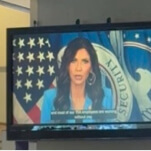Over Half a Million Puerto Rican Power Customers Are Still Reportedly Without Electricity
PoliticsOn Friday, Governor Ricardo Rossello and interim director of Puerto Rico Electric Power Authority Justo Gonzalez announced that, months after Hurricane Maria devastated the island, only 55 percent of Puerto Rico’s roughly 1.5 million customers have power. That’s a slow crawl from the 50 percent reported in November and a far cry from his October promise to have restored power for 95 percent of the island by now. The U.S. Army Corps of Engineers has told ABC News that they estimate the island will not have full restoration until May.
Fredyson Martinez, vice president of a union that represents workers with Puerto Rico’s power company, has told the Associated Press that progress has slowed in part due to a lack of equipment and supplies. According to the Los Angeles Times, the U.S. Army Corps of Engineers reports that restoration is further complicated by “rough terrain” and “an aging infrastructure that was not maintained given the island’s 11-year recession.”
-

-

-

-

-

-

-

-

-

-

-

-

-

-

-

-

-

-

-

-

-

-

-

-

-

-

-

-

-

-

-

-

-

-

-

-

-

-

-

-








































